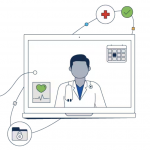As we begin the new year, we are optimistic about our global fight against the coronavirus pandemic. With vaccines starting to be deployed around the world and our healthcare workers seeing critical relief on the horizon, we are hopeful for what the future has in store.
2020 was a year unlike any other. The pandemic served as a catalyst for the transformation of healthcare, supported by the adoption of new, innovative technologies in months vs. years. We are incredibly proud of the opportunity we’ve had to support our customers through this challenging time. While the future is bright, there’s still much work to be done.
Until we have widespread access and uptake of vaccines, our global community will continue to struggle with the pandemic and suffer terrible losses. In the meantime, we will continue working with our customers to address the challenges of today while helping to prepare for a brighter future.
Healthcare is facing global challenges
Physical capacity and the ability to scale clinical care resources for those impacted by the pandemic are critical priorities. Healthcare organizations are doing whatever they can to deliver care to populations globally, and technology can help.
Beyond the immediate needs of patients during the pandemic, we’re expecting to see long-term impacts globally on general population health. Unfortunately, many patients have put off care to avoid high-acuity locations, hospitals, ERs, and provider offices. A recent study showed that diagnosis of six types of cancer decreased by 46.4% during the pandemic. The result of delayed diagnosis is that patients present at more advanced stages and with worse clinical outcomes[1].
At the same time, clinicians are suffering under significant workloads, with much higher levels of stress and anxiety. This also goes for the IT staff that’s supporting the clinical environment. We must consider the role that technology can play to help alleviate clinician burnout, both in the near- and long-term.
Not surprisingly, telehealth visits have skyrocketed this year due to the increased need to social distance and limit exposure. According to a recent report by the American Medical Association, “Physicians and other health professionals are now seeing 50 to 175 times the number of patients via telehealth than they did before the pandemic. The report notes that 46% of patients are now using telehealth to replace canceled in-person visits, up from the just 11% of patients who used telehealth in 2019”[2].
New opportunities to evolve
While the pandemic has brought tremendous devastation, a few positive innovations have emerged, and the use of critical technologies accelerated.
Patients and providers now have expanded access to virtual care, which includes applications like Webex for telehealth, population health management, administrative collaboration, care team coordination, and family visits. Virtual care technology makes healthcare more accessible for all people, regardless of their physical location or access to specialists and care providers. For providers, virtual care can help minimize burnout and decrease exposure risk, while enabling them to continue delivering care to patients.
As the number of remote devices increased due to administrative staff working from home, so did the exponential threat of cyber incursions. Healthcare has the highest average cost per breach of any industry today, averaging $6.54 million[3]. Cybersecurity is top-of-mind for healthcare leaders as they scramble to secure network, web, and endpoint connections. Better, more holistic cybersecurity strategies for our healthcare providers mean that sensitive patient data and virtual connections are secure.
The need to do more with less has also driven innovation in delivering location services in clinical environments. Clinical workflows are more complex now, and it’s more important than ever to quickly locate medical devices and equipment. New technologies leverage location data to enable clinical operational efficiency, improve patient throughput capabilities, and monitor asset utilization.
Looking forward
Healthcare institutions are realizing that their investments in technology are more important now than ever before. Not only do new technologies enable them to deliver care to patients wherever they might be, but these technologies make it easier and safer for doctors to visit patients without risking exposure to COVID-19 or other contagious diseases. Based on a recent survey by Cisco and HIMSS, healthcare organizations will continue to prioritize virtual care solutions[4].
The same study shows that while providers are re-allocating budgets, they are realizing that technology must stay at the top of their list. In fact, the same survey shows that mid-pandemic, there is an increase in spending on upgrading IT, in compliance, regulatory, and standardization requirements, in safety and disaster recovery, and in Artificial Intelligence.
Most importantly, we recommend healthcare organizations take a holistic approach to addressing the issues. There is a need for immediate response, but then for a longer-term strategy to deal with increased uncertainty, waves of the pandemic, the need to continue serving patients and supporting a remote workforce.
As our worldwide battle against the coronavirus pandemic wages on, we at Cisco want to reiterate our support. We are here for your healthcare organization and are committed to supporting you through this pandemic. We are incredibly grateful for our frontline healthcare workers and applaud you for your great work and sacrifice. Here’s to a new year, new innovations, and better health for all.
Read the latest thought leadership from Cisco in the #HealthcareNow series.
- https://www.healio.com/news/hematology-oncology/20201001/sharp-declines-in-new-cancer-diagnoses-observed-during-covid19-pandemic
- https://www.ama-assn.org/practice-management/digital/after-covid-19-250-billion-care-could-shift-telehealth
- https://www.cisco.com/c/en/us/solutions/industries/healthcare/security-and-compliance.html?ccid=cc001016
- HIMSS Survey, Healthcare Technology: Understanding New Priorities, U.S. and U.K., October 2020


CONNECT WITH US